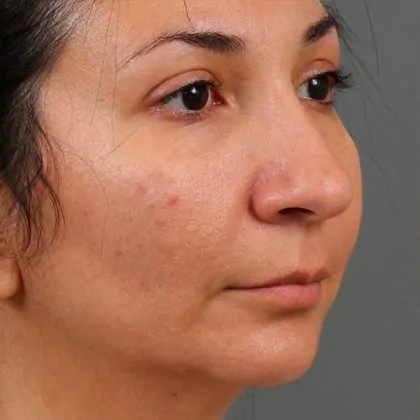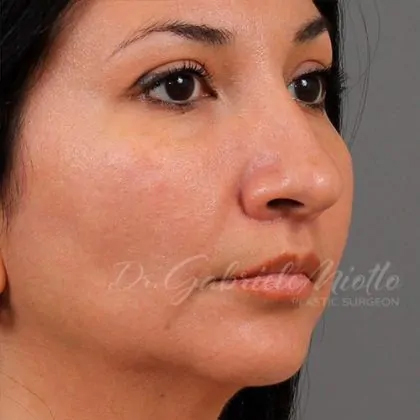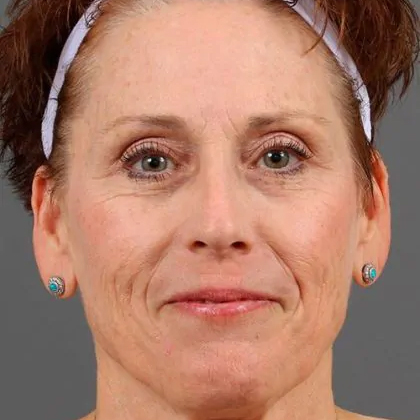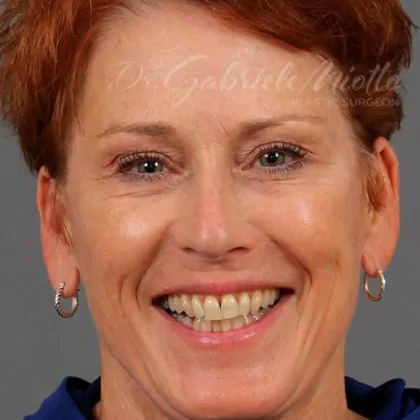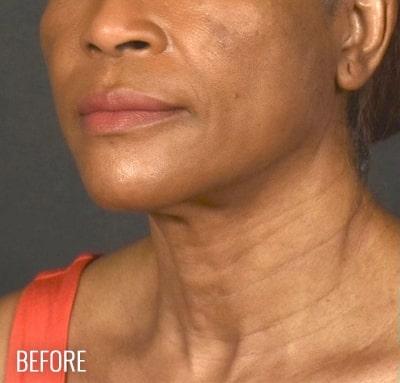Vertical Neck Lift
Conveniently located to serve the areas of Atlanta, GA

A smooth neckline can greatly enhance an individual’s overall appearance. However, just like the rest of the body, as time passes, the signs of aging become evident in the neck. Age-related neck characteristics include excess fat pockets, loose skin, horizontal and vertical banding. Dr. Gabriele Miotto of ME Plastic Surgery addresses these changes with surgical procedures. These procedures include the vertical neck lift (aka platysmaplasty or short-scar cervicoplasty/short-scar neck lift) and the traditional neck lift (aka cervicoplasty or direct neck lift).
Contents
- 1 Before and After Photos
- 2 Patient story
- 3 Neck contouring surgery
- 4 Vertical neck lift goals
- 5 Neck contouring
- 6 Face and neck changes
- 7 Additional procedures
- 8 What issues can plastic surgeons address with a vertical neck lift?
- 9 Consultation
- 10 What to expect
- 11 Preparing
- 12 Procedure
- 13 Surgery Day Expectations
- 14 The surgical procedure begins
- 15 Liposuction
- 16 Tumescent fluid injection
- 17 Removing the fat
- 18 Closing the incision
- 19 Neck Compression Garment Use
- 20 Surgical Drain Placement
- 21 Skin adhesives and steri-strips
- 22 Scar treatment
- 23 The recovery room
- 24 The compression garment
- 25 Vertical Neck Lift Recovery
- 26 Results
- 27 Possible complications
- 28 Risks
- 29 FAQ
Before and After Photos
Patient story

This is a female patient in her 60’s who wanted to improve the central neck laxity and crepey skin. She did not want to do anythingelse to her face. We performed a neck lift with platysmaplasty to improve the neck laxity and contour.
Neck contouring surgery
With a neck contouring procedure like the vertical neck lift, Dr. Miotto creates the patient a neck that appears smoother, firmer and well-defined.
Even if a patient chooses to have neck contouring without the addition of facial rejuvenation procedures (e.g., a facelift), the patient’s facial features do benefit from neck contouring procedures (e.g., a vertical neck lift). The more youthful-looking neck and well-defined jawline can help restore facial harmony, which can take years off an individual’s face.
Vertical neck lift goals
The surgeon’s goal during a short-scar neck lift in Atlanta is to improve the appearance of the patient’s neck by removing excess fatty tissue from above and from below the platysma muscle. In addition, the surgeon uses permanent sutures to tighten the patient’s platysma muscles. After a platysmaplasty, the patient’s vertical neck muscles are less prominent, with and without movement. Furthermore, the patient’s neck appears more youthful, which positively affects his or her overall appearance.
Neck contouring
The patient’s aesthetic goals dictate whether a vertical neck lift or traditional neck lift offers the greatest benefit. Dr. Miotto uses her experience to determine which procedure the patient will benefit from the most. For example, when she is only addressing loose platysma muscles, the neck contouring approach she uses is the vertical neck lift. During a platysmaplasty, Dr. Miotto tightens the loose neck muscles. The approach for addressing a turkey wattle is entirely different from the approach to address loose muscles. To address a turkey wattle, Dr. Miotto performs a traditional, full neck lift in which she removes the excess skin and fat pockets in the neck. Nonetheless, patients can ask her to tighten their platysma muscles during their full neck lift.
Face and neck changes
Plastic surgeons can perform neck contouring procedures alone or at the same time as other facial plastic surgery procedures.
When a patient has developed signs of aging on his or her face (e.g., marionette lines, nasolabial folds, etc.) as well as on the neck (e.g., loose platysma muscles) he or she should consider addressing both, simultaneously. If the patient only addresses one of these issues, the difference in the signs of aging between the two may be noticeable.
Performing several procedures during the same surgical session provides a patient with a more comprehensive result. Furthermore, addressing the signs of aging in the neck and the face simultaneously ensures that the results appear natural.
Additional procedures
The eyes, face and neck work together to create an individual’s unique facial characteristics. As such, many patients want to make the most of their surgical session by having the plastic surgeon address multiple issues during a single surgical session. At ME Plastic Surgery, Dr. Miotto performs vertical neck lifts with a variety of other procedures during the same surgical session. For example, patients frequently have a facelift and vertical neck lift during the same surgical session.
Some of the procedures that a plastic surgeon performs during a patient’s platysmaplasty include
- A rhytidectomy (i.e., a facelift)
A rhytidectomy (i.e., a facelift) — a plastic surgeon performing a facelift without some type of neck contouring procedure is a rarity. By combining a vertical neck lift with a facelift, the surgeon addresses limp neck tissues and lax muscles as well as sagging cheeks and jowls during the same surgical session. - A rhinoplasty (i.e., cosmetic nose surgery, a nose job)
A rhinoplasty (i.e., cosmetic nose surgery, a nose job) — the key to an attractive face is balance. Reshaping the nose to make it proportional with the rest of the patient’s face while improving his or her jawline creates facial balance. - A chin augmentation
A chin augmentation — during a vertical neck lift, to augment the size and shape of a receding chin, an experienced plastic surgeon can place a permanent implant around the patient’s natural chin bone. By enhancing a weak-looking chin, the patient’s facial balance improves. - Excess skin removal
Excess skin removal — if sagging neck skin is causing a patient to have a turkey neck, Dr. Miotto addresses this problem by removing excess skin during a platysmaplasty. - Pockets of fat
Pockets of fat — when there are pockets of fat present in the neck, the plastic surgeon can remove them via liposuction.
Patients requiring removal of excess skin and fat may be better candidates for the traditional, full neck lift.
What issues can plastic surgeons address with a vertical neck lift?
A plastic surgeon performs platysmaplasty procedures to tighten loose platysma muscles. To ensure the platysma muscles remain tight, the surgeon applies permanent interlocking sutures below the submandibular line. These interlocking sutures essentially create an artificial ligament, which secures the muscles to ensure they remain in place. By tightening and securing the neck muscles, the surgeon permanently improves the angle of the patient’s neck. In addition, if warranted, the surgeon can use liposuction to remove fat deposits that have accumulated above or below the neck muscles.
Consultation
Patients do fill out registration information therefore please arrive a little early. The surgeon needs to know about the patient’s medical history. Surgeries, medications, chronic health conditions as well as vitamin and herbal usage must be included on the registration information. In addition, the patient needs to include any allergies he or she has to medications or latex.
What to expect
- Discussing the ideal outcome following a vertical neck lift:
Discussing the ideal outcome following a vertical neck lift: — at their consultation, patients need to be candid with the surgeon about what they want to accomplish with a vertical neck lift. If the patient is also interested in learning more about the facial procedures that are frequently performed during the same surgical sessions, please let the surgeon know of this desire. - Examining the Neck
Examining the Neck — the surgeon will most likely examine the patient’s neck. The surgeon or another medical professional takes pictures of the patient’s neck. These photos are private, which means that ME Plastic Surgery will never use them for promotional purposes without the patient’s written consent to do so. - Measurements
Measurements — the surgeon may also take measurements of the patient’s neck. The surgeon uses the examination, photos and measurements to create the patient a personalized vertical neck lift procedure plan.
The surgeon uses the examination, photos and measurements to create the patient a personalized vertical neck lift procedure plan.
Preparing
Since alcohol increases inflammation, patients need to avoid alcoholic beverages for at least a week.
Certain medications (e.g., Aleve, ibuprofen, aspirin) are known to thin the blood; therefore, patients need to avoid these medications for at least a week, but preferably for the 10 days leading up to his or her vertical neck lift. Patients who need to take pain medication during these 10 days can safely use non-aspirin (aka acetaminophen, Tylenol).
To reduce the likelihood of developing an infection, patients who smoke, or use other products that contain nicotine, must stop using them for at least four weeks before and four weeks after their platysmaplasty. Nicotine causes blood vessel contractions, which decreases the amount of blood that can readily flow through, thus, negatively affecting the ability of the blood to flow through these vessels, which slows the body’s natural healing process. A slow healing process can result in the development of an infection and tissue death.
Patients need to take 14 days off work or school. Doing so provides the patient with an adequate amount of time to heal.
Stock up on healthy foods and beverages, especially water. Doing so now eliminates the need to go shopping within the first week of recovery. In addition, patients who take prescription medications need to have their prescriptions filled ahead of time. Patients who are not sure about whether they can take their medications following surgery should contact ME Plastic Surgery to inquire.
Since patients receive general anesthesia during a vertical neck lift in Atlanta, they must bring a licensed driver with them on the day of their platysmaplasty. In addition, since patients are groggy following surgery, patients should choose an individual who is capable of helping them remain steady while heading out to the car and into the house. In addition, Dr. Miotto wants her patients to have someone remain with them to serve as a caregiver for at least the initial 24 hours, ideally 36 hours, after their vertical neck lift in Atlanta.
Procedure
This surgical procedure takes anywhere from two to three hours.
The patient needs to inform the receptionist of his or her arrival. Patients who arrive without a driver need to reschedule.
Surgery Day Expectations
Pre-op
Me plastic surgery’s pre-op nurses prepare the patient for surgery
- The patient receives a gown to wear.
- The nurse checks the patient’s vitals (e.g., blood pressure, heart rate, oxygen level).
- The surgeon will visit the patient in pre-op. The surgeons at ME Plastic Surgery encourage their patients to ask any last-minute questions they have about their surgery at this time.
- The surgeon creates markings on the patient’s neck. The surgeon uses these markings as a guide while performing the patient’s surgery.
- After answering all the patient’s questions, the surgeon leaves to prepare for his or her surgery.
Directly before the procedure
- The patient receives anesthesia.
- Once the patient is comfortably asleep, he or she is ready to have a vertical neck lift in Atlanta.
The surgical procedure begins
- The surgeon creates a small, very discreet, 1 cm incision underneath the chin.
- The surgeon inserts an endoscope through this incision.
- The endoscope allows the surgeon to see the platysma muscles.
- The surgeon tightens the neck muscles before suturing them together. The interlocking technique the surgeon uses resembles the lace corsets frequently seen on gowns during the Victorian Era.
- By suturing the muscles together, the surgeon creates a single layer of muscle (i.e., a midline platysma plication), which reduces the visibility of the vertical neckbands.
Liposuction
Most patients who need a platysmaplasty also benefit from fat removal in the neck region. If the patient desires, Dr. Gabriele Miotto can perform the platysmaplasty procedure with liposuction. Performing these two procedures simultaneously helps patients attain the beautifully contoured neck they desire.
Tumescent fluid injection
The surgeon injects tumescent fluid into the location where the fat that the surgeon intends to remove is. Tumescent fluid contains the anesthetic lidocaine, which is the same anesthetic dentists use while performing dental procedures. This fluid makes it easier to remove the fat, reduces the amount of bleeding the patient experiences during the procedure as well as after his or her surgery. Another benefit of the reduction in bleeding is a decrease in post-op bruising.
Removing the fat
The surgeon inserts a thin, hollow tube (i.e., a cannula) into the area where the fat pockets are. The cannula attaches to a vacuum that is specifically designed to remove unwanted fat from the body.
The surgeon carefully and strategically moves the cannula to the areas that have fat deposits.
Closing the incision
Once fat removal is complete, the surgeon closes the external incision.
Neck Compression Garment Use
After the vertical neck lift, the patient receives a neck compression garment. This garment provides support for the neck and helps reduce inflammation, which inadvertently reduces pain.
Surgical Drain Placement
A surgical drain provides a place for excess fluid to exit the body, which helps reduce inflammation. The surgeon removes this drain in the office a day or two after surgery.
Skin adhesives and steri-strips
While closing the external incision, the surgeon may use skin adhesives and Steri-Strips. These remain in place for about a week.
Scar treatment
Although the incisions the surgeon creates are well hidden, some patients still want to use a scar treatment. Patients can begin using scar treatment once they are two weeks post op.
The recovery room
After surgery, many patients remain asleep for a bit longer.
Once the patient awakens, he or she receives information about wearing the compression garment, restrictions during recovery as well as what warrants a call to ME Plastic Surgery. The patient also receives information about when to return for a follow-up visit.
The compression garment
Patients must wear their compression garment 24 hours a day for the first seven to 10 days following surgery.
Once the patient completes the 24 hours a day compression garment requirement, he or she will wear the compression garment for another seven days, but only at night.
Potential side effects following a platysmaplasty
- Bruising.
- Swelling.
- Tingling and numbness.
Vertical Neck Lift Recovery
Patients must refrain from performing exercises until their surgeon releases them to do so. During the first week of recovery, patients need to give themselves some time to heal.
Sleeping at a 45-degree angle helps to keep inflammation down. This sleeping position is usually beneficial for patients recovering from head and neck procedures.
After the first week of surgery patients can begin performing light tasks (e.g., wiping down a counter, making a sandwich).
When patients return to ME Plastic Surgery for follow-up visits, their surgeon will let them know when they can resume exercising, lifting items that have a significant amount of weight, etc.
Results
Following a short-scar neck lift and once healing is well underway, patients enjoy a sharper jawline and a smoother, more youthful-looking neck with platysma muscles that no longer stick out. Furthermore, patients who also asked the surgeon to remove fat pockets will notice that their neck and chin area are more slender. The results of a platysmaplasty are long-lasting (10 to 15 years).
Potential side effects following a platysmaplasty
- Bruising.
- Swelling.
- Tingling and numbness.
- A tight feeling in the neck. This feeling usually resolves within a few months of surgery.
Possible complications
Significant complications following a platysmaplasty are unlikely, regardless; patients need to know about them.
Risks
- Excessive bleeding.
- The development of an infection.
- A seroma.
- Changes in the sensations of the neck.
- A hematoma.
- Visible scarring.
- An allergic or adverse reaction to the medicines or products the surgeon uses during surgery.
- An adverse reaction to the medicines the patient receives to put him or her to sleep.
- Underlying structural damage.
- The patient may find the results to be unsatisfactory, at which point additional procedures may be necessary.
Although these complications are rare, choosing an experienced plastic surgeon is one of the best ways to reduce the likelihood of a complication even more.
Dr. Gabriele C. Miotto is a Brazillian-American plastic surgeon specialized in aesthetic surgery and minimally invasive procedures, specially of the face, eyes, nose, breast and liposuction. Call (404) 850-5851 for your consultation.
FAQ
Who can benefit from a vertical neck lift in atlanta?
Men and women who notice that when they make certain facial expressions the vertical muscles of their neck (i.e., platysma muscles) become visible may want to consider learning more about a short-scar cervicoplasty. Active platysmal banding refers to the visibility of the vertical neck muscles while an individual is making certain facial expressions.
What happens if an individual neglects to seek treatment for vertical neckbands?
Once an individual notices the vertical neckbands, if he or she neglects to seek treatment, these bands may eventually remain visible even when he or she is not making any facial expressions. Once the platysmal banding progresses to this stage, it is referred to as passive platysmal banding.
Where can someone in atlanta have a vertical neck lift?
Any adult who has vertical neckbands that are bothersome should consider having a platysmaplasty. Individuals in Atlanta or its surrounding areas should consider making an appointment with experienced facial plastic surgeon Dr. Gabriele Miotto.
What are the differences between a short-scar cervicoplasty and a traditional neck lift?
During a platysmaplasty, the plastic surgeon tightens the platysma muscles, which are responsible for creating the visible bands in the patient’s neck. These bands result when the platysma muscles themselves become loose. To eliminate these visible bands in the patient’s neck, the plastic surgeon lifts the platysma muscles and secures them using permanent sutures. If the patient desires, the surgeon can also use liposuction to remove excess fat from beneath the chin as well as from above and below the platysmal muscles. Typically, during a vertical neck lift the surgeon does not remove any excess skin; therefore, patients with visible platysma muscles and excess skin need to have the direct neck lift in conjunction with the platysmaplasty procedure.
During a traditional neck lift in Atlanta, the plastic surgeon addresses a turkey wattle by removing the sagging, excess skin responsible for creating it. In addition, the surgeon smooths out the wrinkles throughout the patient’s neck and removes pockets of fat via liposuction. If the patient has visible platysma muscles, the surgeon can also use permanent sutures to tighten these muscles.


